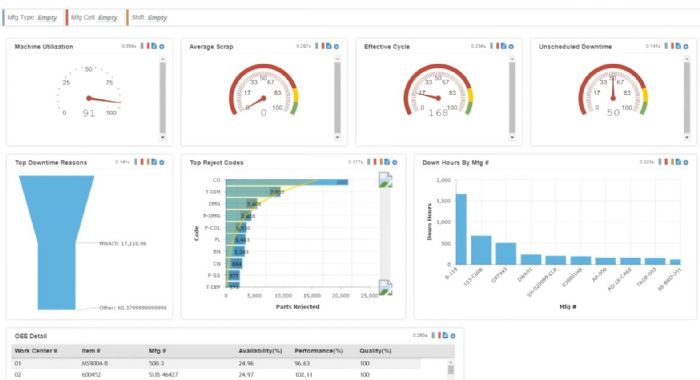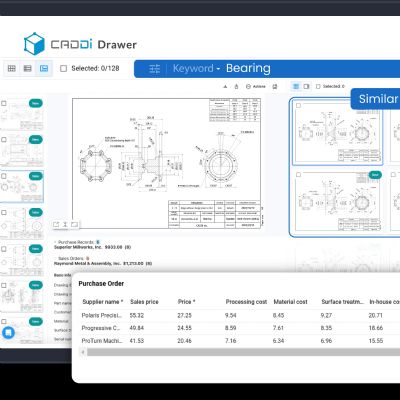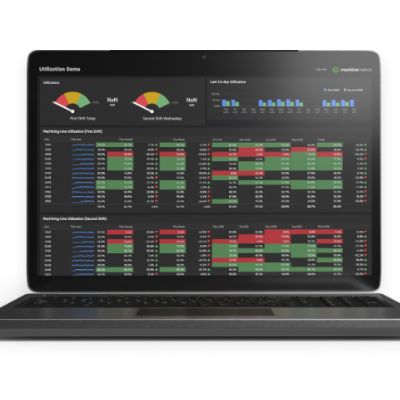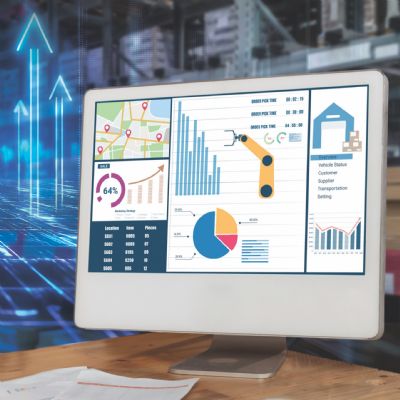Available sensors support different types of data collection
that enable manufacturers to track various metrics related to productivity,
consumption and wear, among other factors. The sensor types metal formers most
likely will find useful:
Proximity sensor—typically attached to a machine and used for counting. One sensor may might capture each part produced, while another might help determine how many feet of material have passed through a machine. Comparing those two measures can, for example, help the team understand scrap rates and percentage of loss.
Amperage and pressure sensors—can provide production and shear rates. Amperage sensors can be associated with machine speed and force of tooling. Meanwhile, pressure sensors can capture similar information for hydraulic machines. Capturing a standard base of amperages and pressures used in the production of each part can help the team determine proper setup, tooling expectations and machine norms. Then, variations of these base measurements can help isolate issues affecting part quality and equipment maintenance.
Vibration sensors—measures the amount and frequency of vibration in each machine or piece of equipment. These measurements, in turn, can be used to detect imbalances and other issues to predict maintenance needs. Additionally, having a vibration base measurement while producing parts can provide a machine signature for good parts and a healthy machine.
Flow meter—can be added to a lubrication-system device to track the amount of lubricant being applied.
Capturing the Data
Sensors provide either digital or analog outputs, with the
data captured by a programmable logic controller or a data logger. These
devices convert the data to a usable format and make it accessible to a shop-floor
network. Newer, smart IIoT sensors can be made directly available to the
network without intermediary devices. Once accessible to the network, the
information commonly routes to a server that supports the Open Platform
Communications (OPC) standard for industrial communications.
The OPC (or other software) may be needed to calibrate the data to match the machine’s own values. For example, an amperage sensor will output a value of 0 to 4095; that value should be calibrated to match the machine’s motor speed or tooling force. From there, the information feeds into a metal former’s enterprise resource planning (ERP) or manufacturing execution system (MES) software, which in turn can populate various real-time reports with the data.
 The ERP or MES software then can maintain current and
historical data, allowing managers to analyze information from the perspective
of quality, efficiency and other key metrics. Manufacturers can use this data
to:
The ERP or MES software then can maintain current and
historical data, allowing managers to analyze information from the perspective
of quality, efficiency and other key metrics. Manufacturers can use this data
to:
- Collect information for end-of-shift reporting, to help
determine if material consumption matches the number of parts that the team
anticipates creating.
- Track counts in a work center, to assist in production
planning.
- Match the work order to what’s running in the machine, to update inventory consumption.
- Compare the number of cycles completed to the number of
parts made, to understand scrap creation.
- Determine downtime for each work center.
- Look for out-of-limit processes.
Real-Time Production and Process Monitoring
While historical information plays a valuable role, the most powerful use of sensors comes from combining the real-time data that they generate with the functionality of real-time production- and process-monitoring software integrated with a manufacturer’s MES and ERP systems.
At a base level, real-time production monitoring helps to
bring meaning to the counts from sensors. In many cases a production cycle can
take mere milliseconds, so production monitoring may be used to capture data
based on cycles that is then displayed as an average (amount of product per min.
or hr.). Counts in ERP and MES also support automated workflows such as
material orders, inventory updates, production scheduling and other shopfloor
and accounting processes.
When metal formers combine statistical analysis with real-time production and process monitoring, they’re able to establish parameters for performance, wear, etc. From there, they can use real-time monitoring to track and flag machine production cycles and identify any processes operating outside of an acceptable range. Additionally, an MES can leverage the data to guide decisions about production and preventive-maintenance scheduling, among other tasks.
Key Performance Indicators (KPIs)
Some common KPIs metal formers use to optimize shopfloor
operations:
Throughput—Monitoring may reveal that when running the same job on two different machines, one machine clearly outperforms the other. With these insights, a metal former can decide to schedule more time-sensitive work on the higher-performing machine and send less time-sensitive jobs to the slower machine.
Downtime—Monitoring and analysis helps sort out scheduled breaks (30 min. of downtime during lunch, for example) versus required breaks needed to perform longer maintenance activities.
Predictive maintenance—The ability to monitor changes in machine vibration, for example, can provide an early indicator of wear that requires predictive maintenance before it creates a downtime issue.
Rate of rejected parts—Tracking reject rates can provide insight into whether a job is set up wrong or if there are actual issues with the machine affecting part quality.
Rate of material consumption—Monitoring material consumption in real time can help metal formers keep an accurate, up-to-date record of inventory to facilitate purchasing decisions and production planning.
One warning: Starting an IIOT project with too many KPIs can ground monitoring and analysis initiatives to a halt, defocusing efforts and consuming valuable staff time along the way. Managers should start with a short list of the KPIs most relevant to their business and regularly compare metrics against these KPIs, and then consider incrementally adding new KPIs.
Ensuring a Successful Start
There are several other actions metal formers can take to
ensure IIOT success with existing equipment. Perhaps the most important: start
with one machine. Too often companies get so excited about monitoring their
shop floor that they set up sensors on several machines at once and end up
disappointed in the results.
The most successful companies get their sensors and monitoring working on one machine and start collecting sample information that everyone agrees is vital and important. Some start with the most difficult machine—a flawed approach because the team must understand the interface and how the software will generate the data.
Instead, we recommend starting with a machine where the team
well-understands how the interface works and can be successful. Even if the
team finds it simple to get up and running, it still will learn plenty through
the process. That knowledge will help
with the rest of the installations and give everyone confidence that the
results will meet expectations.
Metal formers also must avoid the temptation to start using
production or process monitoring on a poorly running machine, since the data
gathered likely will not provide the right insights, which usually requires
going back and starting the process over again. Instead, start with a
well-functioning machine from which the team can collect data and create a
baseline of understanding. This provides a springboard against which to measure
other machines.
When first monitoring the data from sensors, remember that sensors placed on different parts of a machine often will produce different results—even when using the same type of sensor. For example, an amperage meter at a machine’s incoming power source will provide a different reading than a secondary amperage meter located downstream.
Installation Pointers
Metal formers installing sensors for IIOT applications face
some physical implementation factors. In most cases, companies can rely on their
own inhouse maintenance teams for the install as opposed to hiring outside
electricians, because the installers should be familiar with the equipment and
the building itself.
Additionally, consider using wired rather than wireless connections
to each machine; WiFi and wireless devices can perform unreliably on most shop
floors.
Lastly, when finalizing electrical setup, plan for the future by installing network drops on every machine. This will ensure that all machines have network capacity as the team expands the installation of sensors across the shopfloor and begins to collect plantwide data. MF
See also: Dassault Systemes
Technologies: Management, Sensing/Electronics/IOT








 The ERP or MES software then can maintain current and
historical data, allowing managers to analyze information from the perspective
of quality, efficiency and other key metrics. Manufacturers can use this data
to:
The ERP or MES software then can maintain current and
historical data, allowing managers to analyze information from the perspective
of quality, efficiency and other key metrics. Manufacturers can use this data
to:

